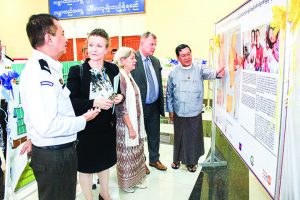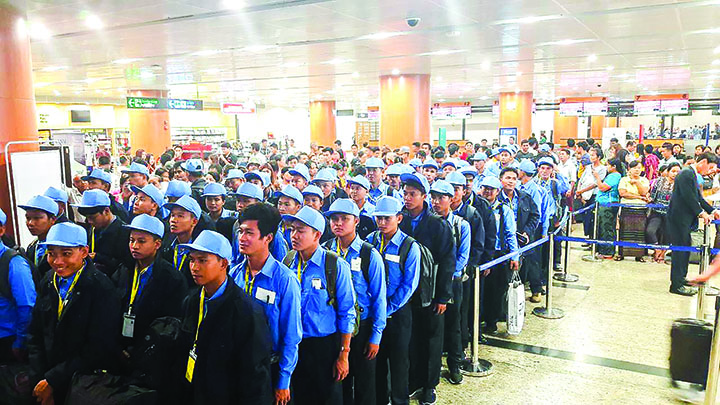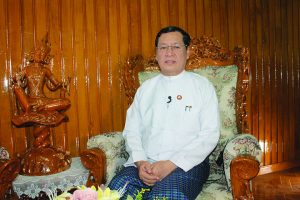22 April
Ministry of Labour, Immigration, and Population (MOLIP) is responsible to protect and ensure the rights of workers through implementing various social rights policies, foster productivity, and addressing matters pertaining to international affairs. The Global New Light of Myanmar met with Union Minister U Thein Swe to catch up on the Ministry’s progress in the 3rd year.
Q: Can you tell us about some of your achievements during your third year in office?
A: Rights and welfare of workers concern the whole nation. Between 1 April 2018 and 28 February 2019, there were over 9054 additional positions open in the government offices with 216,391 openings in the private sector. There is a total of 269 agencies that help employ people from Myanmar abroad legally. Last year, Myanmar sent up to 228,162 workers abroad. We also helped establish 251 new worker unions, 10 job fairs in over 3 regions and states and helped filled 2210 positions.
Q: What are some initiatives to protect Myanmar workers employed abroad?
A: The Ministry is issuing Certificate Of Identity to workers currently in Thailand with no proper documentation. There were 9 mobile centers that issued these certificates with over 66,000 certificates issued between 11 March 2018 to 30 June 2018 and a total 263,135 OWIC cards issued from 1 April 2018 to 28 February 2019. For workers who hold the TR_38 cards, the Myanmar embassy is now allowing Myanmar passport holders to renew their passwords with proper documentation. Myanmar have also signed respective MOUs with the Republic of Korea and Japan to allow workers from Myanmar to have access to employment and training centers the countries.

Q: What are some policies to protect migrant worker safety?
A: Safety of workers is very important. We are trying to train our Labour Exchange officers, General Administration Officers (GAD) and Ward and village administrators to be able to provide accurate and relevant information on safe migration to potential migrants and their families. Hopefully, this will help them make more informed choices and avoid traffickers and other illicit agencies.
Q: What are some programs by the ministry to train skilled workers?
A: We have different standards by the National Skill Standard Authority based on the worker’s ability and expertise. The program, to this date, have graduated 3622 level 1 workers and 472 level 2 workers.
Q: Can you explain more about the national minimum wage initiative and documenting the workforce?
A: Currently, the hourly minimum wage is 600 kyats per hour and 4800 kyats per day. The law doesn’t apply to family owned businesses and small businesses under 10 employees. For factories, the minimum wage for workers have been enforced since 2013. We started our data collection for people who are employed in 2015 and will continue to survey in 2019. The survey goes bi-annually and collets up till 14040 households every 6 months.
Q: What about the laws and regulations?
A: There are 13 laws concerning employment, labor and immigration. We are planning to draft more for foreign workers in Myanmar along with laws on safety and regulations in workplaces. The laws are expected to be discussed in the parliament after review by the Attorney General.
Q: Can you elaborate on the Social Security system in Myanmar?
A: Within the 3rd year of the current administration, there were over 1,239,229 people who were reimbursed medical costs from 32,119 offices. Over 391 million Kyats covered medical costs for 8359 cases and 10,709 million Kyats more paid for 221,859 cases as damages. The ministry is trying to reform our IT system to makes things more stream lined and efficient in addition to the medical reform to create a provider-purchaser split system for healthcare. There is also a 2018-2023 project roadmap to eradicate child labor and we are currently drawing up a step-by-step plan to achieve the objectives in the roadmap. There is currently a draft regarding child labor in over 20 industries and 108 sub categories and is expected to come out in early 2019. The National Committee for Eradication of Child Labor is headed by our Vice President.
Q: How about dispute resolution between workers and employers?
A: During our 3rd year in administration, 332 million Kyats and 16,047 USD were awarded to 1219 employees from 68 disputes that were judged by the Council. From the township dispute resolution offices, there were 1173 settlements out of 1275 disputes and 102 transferred to the state level. A total of 1400 million Kyats and 300 USD were awarded to 3756 employees.
Q: There are relaxation on visa restrictions. Can you tell us more about it?
A: There are 12 types of visas for foreigners entering Myanmar. The ministry added two additional types of visa for family and guests of diplomats and added two more countries (Ukraine, Russia) to 53 countries eligible for Visa on Arrival. The VOA is available in Yangon, Mandalay and Nay Pyi Taw international airports for different types of visa. Since the implementation of visa on arrival, Myanmar have received over 19 million USD from 398,213 world travelers. E-visas are available for tourists from 100 countries and 55 countries for business visas from 3 international airports and Myanmar-Thai and Myanmar-India international checkpoints. Express e-tourist visas are available as well within 24 hours. Myanmar have received over 42 million USD from over 1.1 million visitors.
There are visa-free agreements with ASEAN countries and 23 other countries for diplomat passports. For normal passports, Myanmar citizens can travel to ASEAN countries visa free except for Malaysia. Starting October 2018, Myanmar passport holders can visit up Hong Kong and Macau visa-free.

MAPPS (Myanmar Advanced Passenger Processing System was installed in Yangon International Airport that lets us see Black Listed passengers starting March 2018. Repatriation efforts are also in order with 68 applications for Myanmar citizens approved out of 117 applicants who are reapplying for citizenship after losing it.
Foreigner Registration Cards are also being issued with 480 approved out of 590 applicants. We are trying to update our Border Control System (BCS) into international standards at the ariports and border gates.
Q: How about repatriation efforts for people who had to flee due to conflict?
A: There are repatriation centers for people who are coming back to Myanmar by land or sea. UNDP, UNHCR and our own Ministry is working together as promised in the MOU singed 6th June 2018. The Technical Working Groups have been founded to check whether people coming back have lived in Rakhine or not and are reporting back to the National office. Not only for the people who had to flee their homes in Rakhine, we are also issuing NV cards for people who are fleeing war zones in Myanmar. There were 67699 MV cards issued so the people will be able to have an identification card that proves they are Myanmar citizens. For example, from the 19 IDP camps in Kachin, we helped 29351 people apply for new NRC cards due to lost/damage to the cards. The people in Rakhine IDP camps were also given a type of identification with almost 4500 new identification documents issued.
With the help of NeID system, we were able to collect and account for 237,487 people. The ministry is also trying to collect biographi data and biometric data starting with the prisons and people in custody of the police from different states and regions.
Regarding the 1 million migrant workers from Myanmar that are currently in Thailand, we were able to get CI cards for 35780 people out of 39509 applicants. There are committees being formed and consultants hired for an e-government to go online so the ministry will be able to utilize e-ID.
Q: What about the National Census?
A: We publish population data on our website and facebook. There are forward projections on population here in Myanmar up till 2031. The Ministry also distributes the Micro Data Set on request and maintains the Master Sample Frame from 2014 census. To capture a more accurate population snapshot in 2023, we are planning to have a national census in November.
GNLM



